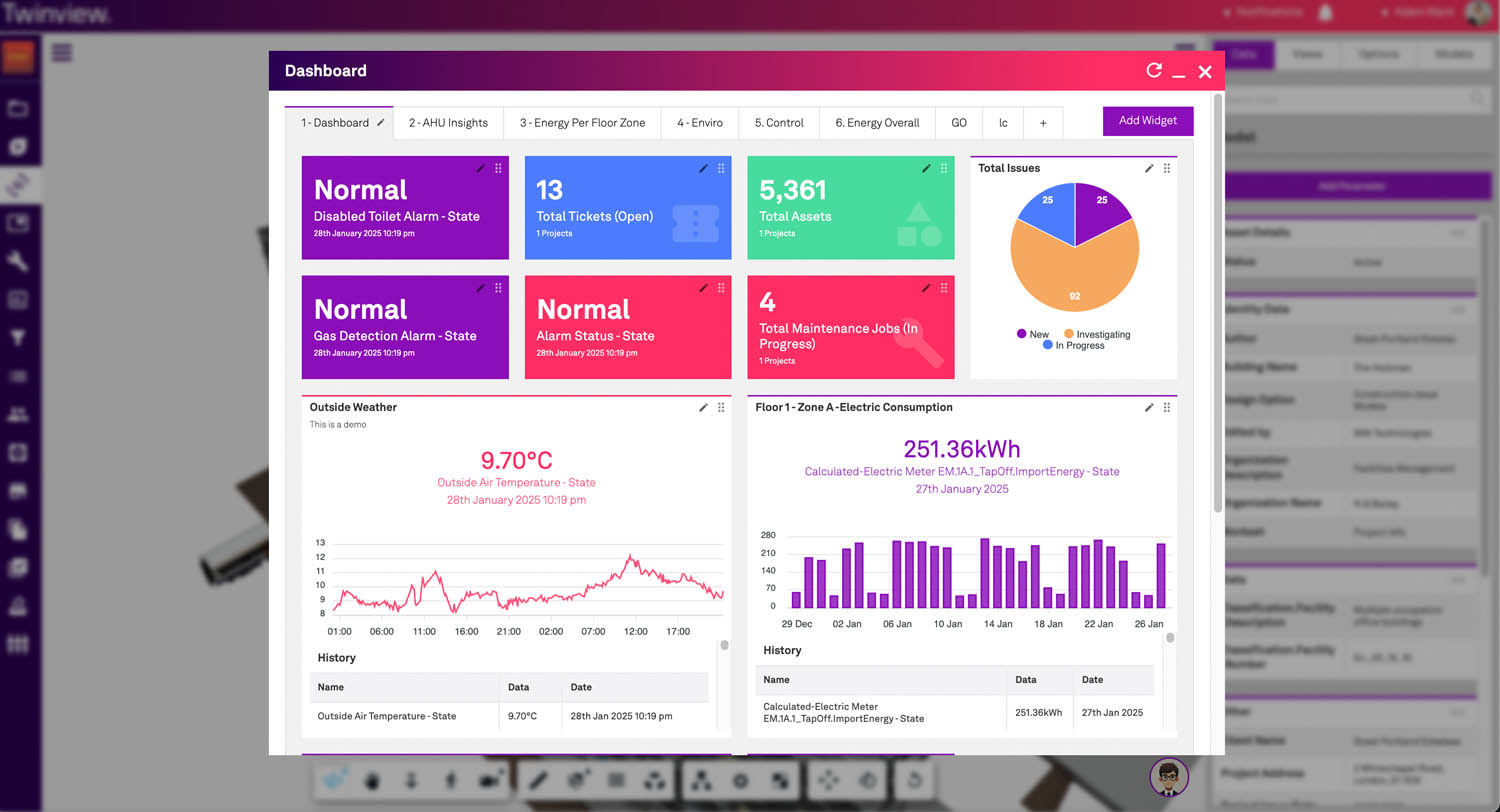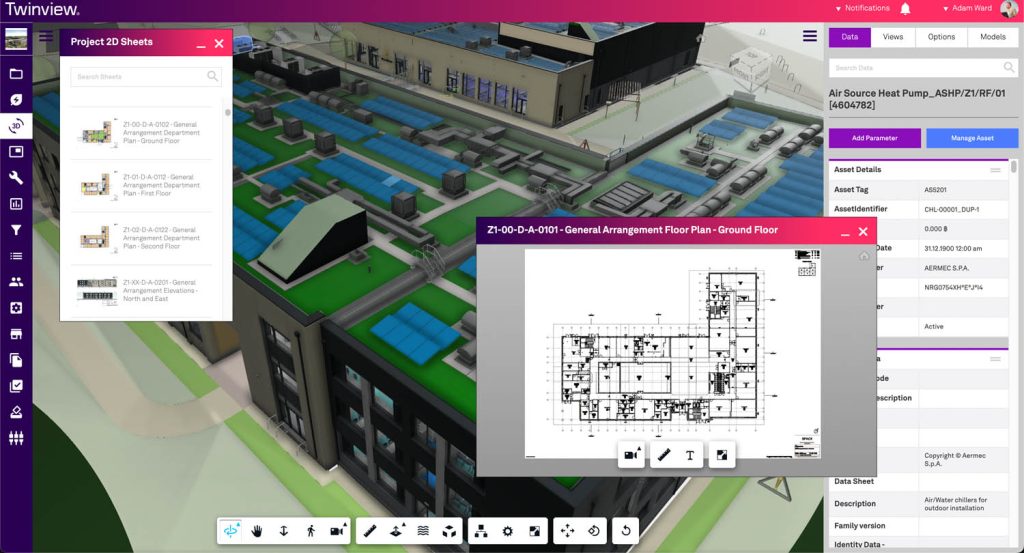AEC Magazine caught up with Rob Charlton, CEO of Newcastle’s Space Group to talk about digital twin adoption and advances. Twinview, created by the company’s BIM Technologies spin off, is one of the most mature solutions on the market today and now has global customers
It’s tough being one of the first to enter a market but for Space, one of the country’s most BIM-centric architectural practices, it was a case of needs must. In 2016, its BIM consultancy spin-off, BIM Technologies, identified a need for its clients to be able to access their model data without the need for expensive software or hardware. Development started and this eventually became Twinview, launched in 2019.
Space Group is a practicing architecture firm, a BIM software developer, a services supplier, a BIM components / objects library creator and distributor. So, not only does it develop BIM software, it also uses the software in its own practice, as well as sell its solutions and services to other firms.
Find this article plus many more in the March / April 2025 Edition of AEC Magazine
👉 Subscribe FREE here 👈
Selling twins
In previous conversations with CEO Rob Charlton on the market’s appetite for digital twins, he has been frank in the difficulty in getting buy in from fellow architects, developers and even owner operators. The customers who got into twins early were firms that owned portfolios of buildings which were sold as eco-grade investments.
Charlton acknowledges that he always expected it to be a long-term endeavour, “We started this development knowing it was it was a five year plus journey to any level of maturity or even awareness”. He draws a parallel to the adoption of BIM, recalling that even though Space bought its first license of Revit around 2001, it didn’t gain significant traction until around 2011, and even then, this was largely due to UK BIM mandates.
The early digital twin market development was a ‘slow burn’. Charlton contrasts BIM Technologies’ patient, self-funded approach with companies that seek large VC funding, arguing that “ the market will move at the level it’s ready for”.
He explains that the good news is that over the last year, there has been an increase in awareness of the value
of digital twins, particularly in the last six months.
This awareness is seen in the fact that clients are now putting out Requests for Proposals (RFPs) for digital twin solutions. For Charlton, this is a fundamental difference compared to the past, where they would have to approach firms to explain the benefits of digital twins. Now, the clients themselves have made the decision that they want a digital twin and are seeking proposals from providers.
Priorities and needs
There’s a lot of talk about digital twins but very little talk concerning the actual benefits of investing in building them. Charlton explains a lot of twin clients are increasingly interested in reducing carbon in buildings, whether that be in embodied or operational and compliance and safety. “It’s an area that Space is particularly passionate about but there is an inconsistency in how embodied carbon reviews and measurements are conducted,” he says.
Customer access to operational data is also important, explains Charlton, “Clients want to gain insights into how their buildings are actually performing in real time.”
He also notes that the facilities and the integration with facilities management is equally important, to streamline maintenance, manage issues, and improve overall building operations.
Clients value the ability to have “access to their information in one place” adds Charlton. And here, the cloud is the perfect solution to deliver a unified platform which consolidates models, and documents related to building assets.
Twinview clients are especially interested in owning their own data. Charlton gives the example of a New Zealand archive project, explaining that the client was particularly interested in having Twinview to maintain independence when using a subcontractor or external service provider, which might come and go over the project lifetime.
Back in the UK, Twinview is being used in conjunction with ‘desk sensors’ on an NHS project to optimise space and potentially avoid unnecessary capital expenditure. Charlton explains that the client was finding the digital twin useful for “analysis on how the space is used” because they were seeking to validate or challenge space needs assessments by consultants.
Increasingly, contractual obligations include performance data. For one of Space’s school clients, the DFA Woodman Academy, there’s a contractual obligation to provide energy performance data at month, three months and 12-months. Digital twin technology facilitated the compliance goal within the performance-based contract. The IoT sensors also identified high levels of CO2 in the classrooms, prompting an investigation into the cause.
Twinview goes beyond the traditional digital twin model for operations and has been used to connect residents to live building information. On a residential project, tenants access the Twinview data on their mobile phones to see energy levels in the buildings, temperatures and CO2, all through their own app.
Artificial Intelligence
Everyone is talking about AI, and Twinview now features a ChatGPT-like front end. This enables plain language search within the digital twin, both at an asset level and with regards to performance data. Charlton explains that while the AI in Twinview has a ‘ChatGPT-like interface’, it is not directly ChatGPT, although it does connect to it. He explains that Twinview developed its own system. This is possibly due to the commercial costs associated with using ChatGPT for continuous queries. The AI in Twinview accesses all building information, including the model, operational data, and tickets, which are stored in a single bucket on AWS. Looking to the future, Charlton mentions that the next stage of AI development for Twinview will be focused on prediction and learning. This includes the ability to generate reports automatically (e.g. weekly on average CO2 levels), predict future energy usage, and suggest ways to improve building performance. A key differentiator for AI in Twinview in the future, will be in its capacity to understand correlations between disparate datasets that are often siloed, such as occupancy data, fire analysis, and energy consumption. By applying a GPT-like technology over this connected data, the aim is to uncover new insights and solutions.
Development Journey
From a slow burn start, despite being a relatively small UK business and competing with big software firms with
deep pockets, Charlton told us that Twinview had already won international clients and is currently being
shortlisted for other significant international projects, including one on the west coast of America, against international competition.







